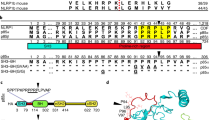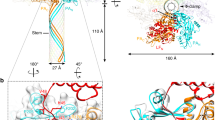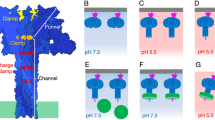Abstract
Lethal factor (LF) is a protein (relative molecular mass 90,000) that is critical in the pathogenesis of anthrax1,2,3. It is a highly specific protease that cleaves members of the mitogen-activated protein kinase kinase (MAPKK) family near to their amino termini, leading to the inhibition of one or more signalling pathways4,5,6. Here we describe the crystal structure of LF and its complex with the N terminus of MAPKK-2. LF comprises four domains: domain I binds the membrane-translocating component of anthrax toxin, the protective antigen (PA); domains II, III and IV together create a long deep groove that holds the 16-residue N-terminal tail of MAPKK-2 before cleavage. Domain II resembles the ADP-ribosylating toxin from Bacillus cereus, but the active site has been mutated and recruited to augment substrate recognition. Domain III is inserted into domain II, and seems to have arisen from a repeated duplication of a structural element of domain II. Domain IV is distantly related to the zinc metalloprotease family, and contains the catalytic centre; it also resembles domain I. The structure thus reveals a protein that has evolved through a process of gene duplication, mutation and fusion, into an enzyme with high and unusual specificity.
This is a preview of subscription content, access via your institution
Access options
Subscribe to this journal
Receive 51 print issues and online access
$199.00 per year
only $3.90 per issue
Buy this article
- Purchase on Springer Link
- Instant access to full article PDF
Prices may be subject to local taxes which are calculated during checkout




Similar content being viewed by others
References
Leppla, S. H. in Comprehensive Sourcebook of Bacterial Protein Toxins 2nd edn (eds Alouf, J. A. & Freer, J.) 243–263 (Academic, London, 1999).
Dixon, T. C., Meselson, M., Guillemin, J. & Hanna, P. C. Medical progress: anthrax. N. Engl. J. Med. 341, 815–862 (1999).
Pezard, C., Berche, P. & Mock, M. Contribution of individual toxin components to virulence of Bacillus anthracis. Infect. Immun. 59, 3472–3477 (1991).
Duesbury, N. S. et al. Proteolytic inactivation of MAP-kinase-kinase by anthrax lethal factor. Science 280, 734–737 (1998).
Vitale, G. et al. Anthrax lethal factor cleaves the N-terminus of MAPKKs and induces tyrosine/threonine phosphorylation of MAPKs in cultured macropahges. Biochem. Biophys. Res. Comm. 248, 706–711 (1998).
Vitale, G., Bernardi, L., Napolitani, G., Mock, M. & Montecucco, C. Susceptibility of mitogen-activated protein kinase kinase family members to proteolysis by anthrax lethal factor. Biochem. J. 352, 739–745 (2000).
Inglesby, T. V. et al. Anthrax as a biological weapon: medical and public health management. Working group on civilian biodefense. J. Am. Med. Assoc. 281, 1735–1745 (1999).
Petosa, C., Collier, R. J., Klimpel, K. R., Leppla, S. H. & Liddington, R. C. Crystal structure of the anthrax toxin protective antigen. Nature 385, 833–838 (1997).
Benson, E. L., Huynh, P. D., Finkelstein, A. & Collier, R. J. Identification of residues lining the anthrax protective antigen channel. Biochemistry 37, 3941–3948 (1998).
Klimpel, K. R., Arora, N. & Leppla, S. H. Anthrax toxin lethal factor contains a zinc metalloprotease consensus sequence which is required for lethal toxin activity. Mol. Microbiol. 13, 1093–1100 (1994).
Duesbery, N. S. et al. Suppression of ras-mediated transformation and inhibition of tumour growth and angiogenesis by anthrax lethal factor, a proteolytic inhibitor of multiple MEK pathways. Proc. Natl Acad. Sci. USA 98, 4089–4094 (2001).
Friedlander, A. M. Macrophages are sensitive to anthrax lethal toxin through an acid-dependent process. J. Biol. Chem. 261, 7123–7126 (1986).
Hanna, P. C., Acosta, D. & Collier, R. J. On the role of macrophages in anthrax. Proc. Natl Acad. Sci. USA 90, 10198–10201 (1993).
Pellizzari, R., Guidi-Rontani, C., Vitale, G., Mock, M. & Montecucco, C. Anthrax lethal factor cleaves MKK3 in macrophages and inhibits the LPS/IFNγ-induced release of NO and TNFα. FEBS Lett. 462, 199–204 (1999).
Ballard, J. D., Collier, R. J. & Starnbach, M. N. Anthrax toxin-mediated delivery of a cytotoxic T-cell epitope in vivo. Proc. Natl Acad. Sci. USA 93, 12531–12534 (1996).
Goletz, T. J. et al. Targeting HIV proteins to the major histocompatibility complex class I processing pathway with a novel gp120–anthrax toxin fusion protein. Proc. Natl Acad. Sci. USA 94, 12059–12064 (1997).
Quinn, C. P., Singh, Y., Klimpel, K. R. & Leppla, S. H. Functional mapping of anthrax toxin lethal factor by in-frame insertion mutagenesis. J. Biol. Chem. 266, 20124–20130 (1991).
Gupta, P., Singh, A., Chauhun, V. & Bhatnagar, R. Involvement of residues 147VYYEIGK153 in binding of lethal factor to protective antigen of Bacillus anthracis. Biochem. Biophys. Res. Comm. 280, 158–163 (2001).
Holm, L. & Sander, C. Dali/FSSP classification of three-dimensional protein folds. Nucleic Acids Res. 25, 231–234 (1997).
Carroll, S. F. & Collier, R. J. NAD binding site of diphtheria toxin: identification of a residue within the nicotinamide subsite by photochemical modification with NAD. Proc. Natl Acad. Sci. USA 81, 3307–3311 (1984).
Mock, W. L. & Stanford, D. L. Arazoformyl dipeptide substrates for thermolysin. Confirmation of a reverse protonation catalytic mechanism. Biochemistry 35, 7369–7377 (1996).
Park, S. & Leppla, S. H. Optimized production and purification of Bacillus anthracis lethal factor. Protein Expr. Purif. 18, 293–302 (2000).
Otwinowski, Z. & Minor, W. Processing of X-ray diffraction data collected in oscillation mode. Methods Enzymol. 276, 307–326 (1997).
The CCP4 suite: programs for protein crystallography. Acta Crystallogr. D 50, 760–763 (1994).
Terwilliger, T. C. & Berendzen, J. Automated MAD and MIR structure solution. Acta Crystallogr. D 55, 849–861 (1999).
Roussel, A. & Cambillau, C. 86 (Silicon Graphics, Mountain View, California, 1991).
Brunger, A. T. et al. Crystallography & NMR system: A new software suite for macromolecular structure determination. Acta Crystallogr. D 54, 905–921 (1998).
Wang, X.-M., Mock, M., Ruysschaert, J.-M. & Cabiaux, V. Secondary structure of anthrax lethal toxin proteins and their interaction with large unilamellar vesicles (LUV): a Fourier-transform infrared spectroscopy approach. Biochemistry 35, 14939–14946 (1996).
Bacon, D. J. & Anderson, W. F. A fast algorithm for rendering space-filling molecule pictures. J. Mol. Graphics 6, 219–220 (1988).
Kraulis, P. J. Molscript—a program to produce both detailed and schematic plots of protein structures. J. Appl. Crystallogr. 24, 946–950 (1991).
Merrit, E. A. & Murphy, M. E. P. Raster3D version 2.0. A program for photorealistic molecular graphics. Acta Crystallogr. D 50, 869–873 (1994).
Christopher, J. A. SPOCK: The Structural Properties Observation and Calculation Kit (Program Manual) (The Center for Macromolecular Design, Texas A&M University, College Station, 1998).
Acknowledgements
We thank L. Bankston for discussion and D. Hsu for LF preparations. We thank and acknowledge the staff and facilities of the synchrotron sources at SSRL, Stanford; SRS, Daresbury; ESRF, Grenoble; APS, Chicago; and National Synchrotron Light Source, Brookhaven. Supported by grants from the Medical Research Council and the National Institutes of Health.
Author information
Authors and Affiliations
Corresponding author
Supplementary information
Rights and permissions
About this article
Cite this article
Pannifer, A., Wong, T., Schwarzenbacher, R. et al. Crystal structure of the anthrax lethal factor. Nature 414, 229–233 (2001). https://doi.org/10.1038/n35101998
Received:
Accepted:
Issue Date:
DOI: https://doi.org/10.1038/n35101998
This article is cited by
-
Atomic structures of anthrax toxin protective antigen channels bound to partially unfolded lethal and edema factors
Nature Communications (2020)
-
Single vector platform vaccine protects against lethal respiratory challenge with Tier 1 select agents of anthrax, plague, and tularemia
Scientific Reports (2018)
-
A quantitative comparison of cytosolic delivery via different protein uptake systems
Scientific Reports (2017)
-
Chloroquine derivatives block the translocation pores and inhibit cellular entry of Clostridium botulinum C2 toxin and Bacillus anthracis lethal toxin
Archives of Toxicology (2017)
-
Molecular assembly of lethal factor enzyme and pre-pore heptameric protective antigen in early stage of translocation
Journal of Molecular Modeling (2016)
Comments
By submitting a comment you agree to abide by our Terms and Community Guidelines. If you find something abusive or that does not comply with our terms or guidelines please flag it as inappropriate.




